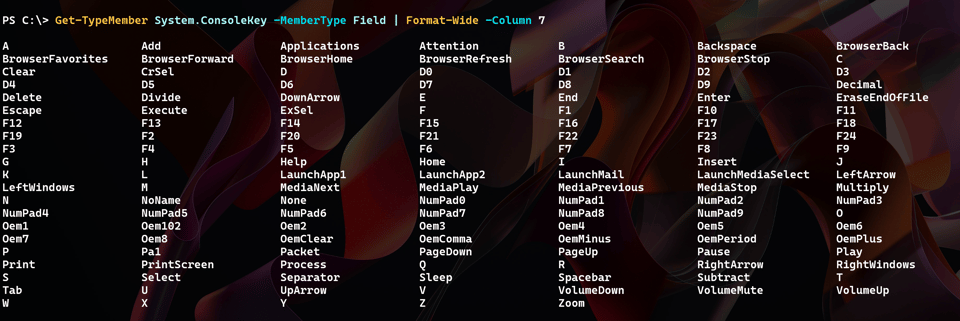Finger Fun: More Keybinding Tips and Tricks
In this issue:
I started my career back in the days of DOS so I am very comfortable working from a keyboard. In the early days of Windows I was a WordPerfect macro master. I would spend hours constructing a WordPerfect macro to automate document creation and management. A macro is just another type of keyboard shortcut.
Since I spend my days working from a PowerShell prompt, i am always looking for ways to speed up my work. I hate reaching for a mouse. I love it when I can type a few keys and have something happen. That's why I love keybindings in the PSReadLine module and Windows Terminal.
I've written about PSReadLine keybindings in the past.
-

PSReadLine Profile Power • Buttondown
The PSReadLine module is one of the most useful tools we have in PowerShell. You utilize it every day without realizing it. An early version of the module...
-

More PSReadLine Power • Buttondown
Last time, I showed you how to customize PSReadLine in your module by taking advantage of examples in the sample PSReadLine profile script. But since this...
But it has been a while since I wrote about keybindings. So, I thought it was time to revisit the topic.
> VSCode and the PowerShell ISE also have keybindings, but I'm not going to cover them here. Although you still need to be aware of potential conflicts.
PSReadLine
The PSReadLine module defines many default keybindings that we use all the time such as Ctrl+r and Ctrl+Space. The keybinding is defined as a chord. A chord is a combination of one or more modifier keys (Ctrl, Alt, Shift) and a System.ConsoleKey value.

Getting KeyBindings
You can run Get-PSReadLineKeyHandler -Bound to see all of the defined PSReadline keybindings. These are grouped by a Microsoft.PowerShell.KeyHandlerGroup value. You can see the available groups by running:
PS C:\> Get-TypeMember Microsoft.PowerShell.KeyHandlerGroup
Type: Microsoft.PowerShell.KeyHandlerGroup
Name MemberType ResultType IsStatic IsEnum
---- ---------- ---------- -------- ------
Basic Field Microsoft.PowerShell.KeyHandlerGroup True
Completion Field Microsoft.PowerShell.KeyHandlerGroup True
CursorMovement Field Microsoft.PowerShell.KeyHandlerGroup True
Custom Field Microsoft.PowerShell.KeyHandlerGroup True
History Field Microsoft.PowerShell.KeyHandlerGroup True
Miscellaneous Field Microsoft.PowerShell.KeyHandlerGroup True
Prediction Field Microsoft.PowerShell.KeyHandlerGroup True
Search Field Microsoft.PowerShell.KeyHandlerGroup True
Selection Field Microsoft.PowerShell.KeyHandlerGroup True
GetType Method Type
HasFlag Method Boolean
ToString Method String
> Get-TypeMember is from the PSScriptTools module.
If I only want to see my custom keybindings, I can run:
PS C:\> Get-PSReadLineKeyHandler -Bound | Where group -eq custom
User defined functions
======================
Key Function Description
--- -------- -----------
Alt+% ExpandAliases Replace all aliases with the full command
F6 Function Menu Display all functions as menu using Out-GridView. [jeff]
F7 HistoryList Show command history with Out-GridView. [jeff]
( InsertPairedBraces Insert matching braces
{ InsertPairedBraces Insert matching braces
[ InsertPairedBraces Insert matching braces
Ctrl+j JumpDirectory Goto the marked directory.[jeff]
Alt+F5 ListMyHandlers List my PSReadLineHandlers [jeff]
Ctrl+Alt+j MarkDirectory Mark the current directory. [jeff]
Alt+k my handlers Show my custom PSReadline key handlers
Shift+F1 OnlineCommandHelp Open online help for the current command. [jeff]
Ctrl+h Open PSReadLineHistory View PSReadLine history file with the associated application. [...
Alt+( ParenthesizeSelection Put parenthesis around the selection or entire line and move th...
Alt+w SaveInHistory Save current line in history but do not execute. [jeff]
Alt+j ShowDirectoryMarks Show the currently marked directories. [jeff
" SmartInsertQuote Insert paired quotes if not already on a quote
' SmartInsertQuote Insert paired quotes if not already on a quote
Adding KeyBindings
I even defined a custom key binding to display my custom keybindings using Format-SpectreTable from the pwshSpectreConsole module
Set-PSReadLineKeyHandler -Chord "Alt+k" -BriefDescription "my handlers" -Description "Show my custom PSReadline key handlers" -ScriptBlock {
Get-PSReadLineKeyHandler -bound |
Where group -eq 'Custom' |
Sort Key |
Format-SpectreTable -Title "[italic gold1]My PSReadLine Key Handlers[/]" -Color 'SpringGreen3_1' |
Out-Host
}

Many of my keybindings are defined in my PowerShell profile. I recommend defining them in a PowerShell script file that you can dot source from your profile. I wish there was a way to export and import the keybindings. Unfortunately, once you register the keybinding, you can't see the associated script block or PSReadLine function which means there's nothing to export. A PowerShell script file is your best option.
Windows Terminal
Where this gets interesting, or potentially more complicated, is when you add Windows Terminal into the mix. Windows Terminal also has keybindings, which might conflict with PSReadLine keybindings, or keybindings you want to use. I'll address that in a bit.
Getting Windows Terminal KeyBindings
The Windows Terminal key bindings are stored in the settings JSON file.
$wtProfilePath = Join-Path -Path $env:LOCALAPPDATA -ChildPath 'Packages\Microsoft.WindowsTerminal_8wekyb3d8bbwe\LocalState\settings.json'
$wtProfile = Get-Content $wtProfilePath | ConvertFrom-Json
The keybinding settings is very simple.
PS C:\> $wtProfile.keybindings
id keys
-- ----
User.splitPane.5B23D113 ctrl+shift+comma
User.sendInput.58CEF08D ctrl+alt+w
User.sendInput.ABD01282 ctrl+t
User.paste ctrl+p
User.copy.644BA8F2 ctrl+c
User.splitPane.AEAAD8C0 ctrl+alt+o
User.newTab.47BA4305 ctrl+alt+;
User.newTab.B1939200 ctrl+shift+u
User.openTabColorPicker ctrl+/
User.splitPane.A6751878 ctrl+shift+s
User.find ctrl+shift+f
User.splitPane.1E0C8766 ctrl+shift+period
User.sendInput.OutputEncoding ctrl+e